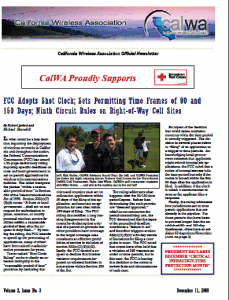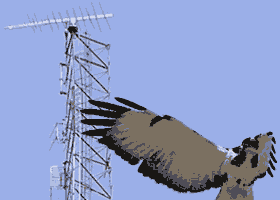I recently posted a message to a list serve run by the League of California Cities aimed at local government planners. That posting has provoked a number of comments, universally positive from local government planners and attorneys. I did receive what might be called a negative response from a wireless industry siting agent.
I’ll let you read the posting, and then the industry agent’s email incorporating my reply. Then I’ll offer a few closing comments and invite you to reply.
I want to alert my local government planning and legal colleagues in Southern California that Sprint/Nextel is now in the process of submitting something on the order of 1,400 applications to local government planning agencies (and potentially to public works departments) for what often appear to be–but are not–modifications to existing Sprint/Nextel sites. Rather, what is happening is that Sprint/Nextel, under its name and logo on the applications and plans, is sponsoring in applications for Clearwire Communications, a separate legal entity under separate management, which is merely 51% owned by Sprint.
Clearwire is a wireless Internet service provider. It is *not* a wireless phone company. Clearwire does *not* hold a CPUC Certificate of Public Convenience and Necessity. Clearwire is not entitled to access the right-of-way in the same way that Sprint/Nextel does. This is particularly important where Sprint sponsors Clearwire applications for ROW sites that really should generate revenue to local governments if the governments elect to approve such ROW incursions.
The Clearwire projects are not existing site modifications by Sprint/Nextel to its own site, but rather entirely new projects (and new RF emissions) from a new and separate legal entity, Clearwire, to be collocated on existing Sprint/Nextel sites. Where Clearwire needs a site but there is no existing Sprint/Nextel site to serve as a platform, the firm is proposing collocations on other existing cell sites. These collocations do *not* automatically occur under Government Code Sections 65850.6 and 65964. There are many triggers that must first occur prior to these code sections kicking-in to require collocation, and its very unlikely they will apply in a particular case involving Clearwire given its multiple microwave and panel antenna systems.
Where no existing sites are available, Clearwire is proposing new sites. Clearwire has indicated that they are typically planting new sites at the rate of about 2 per square mile.
Clearwire’s network design in nearly every case dictates that it use three or four microwave antennas to interconnect each of its sites with that many more other sites, yet the applications I have seen submitted to my government clients are usually coming in one at a time. This piecemeal filing approach raises CEQA questions as Clearwire’s method of submitting individual applications masks the fact that each site is part of a much larger and unified project that cannot operate without the multiple sites communicating with each other, and back to the Clearwire Internet access node (called the POP or point of presence).
For those communities that bar microwave antennas for site-to-site or site-to-switch interconnection because they are unnecessary visual elements, consider whether granting microwave dishes to Clearwire (which is a cost-saving issue for them) will interfere with your future ability to bar or limit microwave antennas to wireless telephone companies.
I recommend that the planning desk look for Sprint/Nextel plans with site numbers formatting like CA-XXX-YYYY, where XXX are three letters related to the county or market where the project is to be located, and YYYY is the specific four digit site number. The site number may be followed by a single letter. If these projects come across the desk, consider whether you are dealing with a single site, or (far) more likely a project, and to proceed with due caution. At the least, consider issuing an incomplete letter and requiring Clearwire to come in and disclose all of their project sites and interconnections, and then consider whether your agency wants to evaluate the entire project under CEQA. More and more governments are now taking that cautious approach.
I have photos of a few Clearwire sites in Portland, Oregon and Modesto, California posted to the government planners wireless example gallery at www.celltowersites.com/gallery/
-Jonathan
The industry member’s response, with my embedded reply back shown in italics, is below:
Hello Jonathan
A colleague of mine forwarded your statement below to me. After reading it, I feel compelled to reach out to you with my own comments. Not entirely clear as to what your objective is, perhaps business is slow for you as with many of us as of late.
JK: As a municipal and private attorney, an RF engineer holding many licenses; and as a contract wireless planner and planning instructor for many governments, my goal is to to ensure that my constituency (governments and selected private entities) is aware of this deployment and the legal and practical considerations that attach to the deployment. Business is just fine, thanks.
Whatever the case may be, your message below is startling and in my opinion, somewhat predatory in nature.
JK: Predatory is defined in the Encarta Dictionary (http://encarta.msn.com/dictionary_1861737372/predatory.html) as:
1. greedily destructive: greedily eager to steal from or destroy others for gain
2. relating to predators: relating to or characteristic of animals that survive by preying on others
3. ruthlessly aggressive: extremely aggressive, determined, or persistent
I respectfully disagree with your opinion that my message suggests predatory behavior. I have no desire to destroy, or the other things in the definitions. Rather, my desire is that my constituency properly understand what is happening with the Clearwire deployment, and why it raises legal and procedural issues that should be addressed as applications are being tendered and considered. As a wireless planner working for governments for the past 17+ years, I believe that most of those on the private site who regularly deal with me would reach a softer or different characterization of my actions.
Your statement regarding ROW is valid. However, this is not applicable to the majority of sites that Clearwire is working on in the Southern California area. Perhaps limiting your message to ROW issues only would have been the better approach here.
JK: I appreciate your recognition of the ROW issue, but is merely one element that permitting agencies need be aware of. Some of the drop/swaps will be proposed for the ROW; many will not. It would not make sense for me to limit my comments to just the ROW since the deployment will likely be in both arenas.
Further, whether the proposal is for a mod to Sprint’s own facility or not, the fact is that on land not located in the public right of way jurisdictions should consider these proposals as a colo/cohab modifications or new-build project regardless of the entity name or CPUC status and review the request on it’s own merit with consideration to the degree of intensification and/or design relative to the land development standards in effect at the time of application.
JK: This is an area where each jurisdiction will evaluate a project against their local municipal code rules, as well as CEQA, and the PUC. Since we’re dealing with different legal entities, and addressing your non-ROW discussion, how the project is understood by the local agency is important to the proper application of the local code. Also, under some local government municipal codes, it does make a difference whether Sprint is proposing a mod to its own site, or if the proposal is really for a new and different occupant that is subject to its own permit process.
You state that “..Sprint/Nextel is now in the process of submitting something on the order of 1,400 applications to local government planning agencies (and potentially to public works departments) for what often appear to be–but are not–modifications to existing Sprint/Nextel sites. Rather, what is happening is that Sprint/Nextel, under its name and logo on the applications and plans, is sponsoring in applications for Clearwire Communications, a separate legal entity under separate management, which is merely 51% owned by Sprint”. Further, you claim that the microwave dishes being proposed is merely a “cost saving issue”. Unless you have some proof of this, I would tend to believe that the statement is unfounded.
JK: A wireless mesh network for backhaul is a cost saving consideration. A WiMax provider could use redundant fiber or multiple T1 network to achieve the same results, but those alternative would involve different capital and recurring cost considerations.
Jonathan, you seem to be suggesting that Sprint/Nextel and Clearwire is acting less than honest about their intent by maintaining the Sprint and/or Nextel name and logo on the plans. I am not entirely comfortable with your statement and am disappointed in you as a “telecom lawyer” for publicly making such accusations.
JK: The fact is that Sprint/Nextel is a separate entity. The firms are managed differently. There are other partners involved. See: http://newsroom.clearwire.com/phoenix.zhtml?c=214419&p=irol-newsArticle_Print&ID=1141157&highlight=
I do not suggest that Sprint/Nextel’s sponsorship of the applications is dishonest, but rather that some may governments and others may see the bold letters at the top of the plans and on the applications that say Sprint/Nextel, and miss the important little letters that disclose that Clearwire is the actual owner of the project. It is not an accusation; but rather a fact that important to properly understand who is requesting what.
Based on my exposure to your work over the years, I think you have done a reasonably good and thorough job representing your public sector clients.
JK: Thank you.
This is why I am so startled by your message below. Your message implies that you have factual information relative to the relationship between parties and their intent as well as the objectives of their site designs relative to cost.
JK: The information regarding the ownership is public record. Their deployment intent is clear from reading the information they have released, and disclosed in public meetings.
You are potentially encouraging local jurisdictions to question the intent of the wireless applicant to a degree that could possibly be prohibitive and questionably illegal relative to legislation that supports such endeavors.
JK: I am encouraging local jurisdictions to ensure that they understand who the actual applicant is and what the rights and duties are of that applicant. Asking for factual and accurate disclosures to permit the local agency to determine the proper course under its local code is neither prohibitive nor illegal in this sense.
Clearly, with 1,400 sites planned (per you), the intent is to provide improved wireless telecommunication service, whether it be for Clearwire or Sprint/Nextel or both. Whether it be for telephone or internet or both, what is the problem here?
JK: Again, the rights that must be respected flow from the legal status of the real applicant. Cell phone companies have rights that are different from Internet-only providers; which are different from, say, trunked radio system operators. Real problem can arise if the rights asserted by an applicant are not the rights as granted to that applicant, and if a permitting agency mishandles an application as, for example, a standalone project rather than as part of a larger multi-site project.
The overall feeling that I have after reading your message is that Sprint/Nextel and/or Clearwire is up to something unethical and potentially illegal.
JK: I respect your right to your feelings, but nowhere in my message did I say or suggest that the actions are either “unethical or potentially illegal.”
The potential for confusion regarding the applicant and its rights I’ve discussed is based on how the applications are already coming in. The comments I’ve received from local governments confirms that the confusion already exists. But confusion does not rise (or sink) to the behavior you incorrectly read into my words.
If I were a city decision maker and after reading your statement I would be very concerned and as such, I may be compelled to question the validity of every Clearwire/Sprint application. In fact, I may even be compelled to question any wireless application more so than I would under normal circumstances.
JK: City decision makers are by and large very smart people, just as you are. As a planner in this area, I’m sure you understand that wireless planning is different and more detailed that planning a building, or permitting a business to conduct a conditional use. Special state rules come into play, as do federal rules and court decisions, when considering wireless site applications. Again, that’s why understanding who the applicant is and their real rights is key to ensuring compliance with the regulatory and judicial framework that controls in this area. Being compelled to question any application more than normal is a personal decision for a planner which is, I believe, largely based on trust factors. This is an area where accurate knowledge prevents the planner from falling into the “Fool me once, shame on you; fool me twice, shame on me” trap.
Your statements may cause discomfort with the local jurisdictions and will likely result is undue delays in processing time as well as cast a negative light on the wireless entities that have every right to build or modify their wireless network in the most efficient and expeditious manner.
JK: Processing of planning applications is governed by various state laws (for example the PSA). If an application comes in that may misstate material information, then the delay…if any…will be due to the entity misstating the information, don’t you agree? And if an entity misstates material information, then who is casting the light you speak of? I do not suggest that Sprint, Clearwire, or anyone else is misstating material information, but confusion does already exist.
The cost of such endeavors should not be such a concern to local planning departments when considering the proposal. Further, when considering the equipment needed to reach the coverage objective, the applicant should use the least intrusive and reasonable means possible.
JK: The cost issue isn’t core. There are many cases where microwave backhaul is appropriate, and I have stated that in various project reviews I have conducted over the years. There are other considerations, however, that come into play in wireless siting within and outside of the right-of-way including, as just two examples, CEQA and ADA compliance.
From what I have witnessed, Sprint and/or Clearwire has made more than reasonable efforts to adhere to this approach. Causing any level of prohibition to this approach is, at a minimum, unfair.
JK: I accept that this is your belief, but I do not adopt or reject it for myself. I’m not sure what you mean by “any level of prohibition” either functionally or legally.
The expectation that I have for someone of your professional stature and experience is to maintain a healthy balance between applicant and jurisdiction and use methods of practice that are proactive and most importantly, fair. Local jurisdictions that enter into contract with you expect that you will review applications for wireless facilities with the intent of making sure that the proposal is consistent with all applicable rules defined in Telecom Act. That stated, perhaps you could take a softer and more cautious approach when advising your public-sector colleagues. I believe that fostering trust among all parties is the better way to do business for all of us.
JK: The Telecom Act may or may not apply; the state collocation laws may or may not apply; various provisions of the local municipal code may or may not apply. There are many considerations, beyond the Telecom Act, that must be factored into proper planning.
I agree with you that fostering trust among the parties is a better way to do business. Trust springs from honesty, so the more honest we are, the greater then trust that we should be accorded.
Over the nearly 20 years I’ve been doing wireless siting work, I have developed a reputation for calling it like I see it, and trying to bring parties together. The wireless industry calls on me to help them develop that trust when they ask me to lecture at industry meetings (as I have several times this year at my own expense, and in previous invited by unpaid trips to lecture at national PCIA conferences, for example).
I am a charter member and public supporter of CalWA and the educational outreach it promotes. I frequently recommend that government officials join CalWA to learn and hear more about the industry. Twice this year, at government conferences that I have coordinated, I have invited CalWA wireless industry professionals to attend and present. My efforts are based on developing a better relationship between the various stakeholders…call it trust…
I would be open to discussing this matter further should you wish. If in fact, if you do possess factual documentation that supports your claims, I would gladly review the information and if valid, consider retracting some of my above-opinions.
Thanks for taking the time to read my comments and consider my suggestions.
JK: Hopefully I’ve addressed the bulk of your comments and concerns. I don’t ask that you change your opinions, but merely that you consider mine as I’ve further explained them in this reply. I’ve taken the time to respond because I found your comments thoughtful, even where I disagree with them. That’s just part of the interplay between peers who clearly respect either other, but may have cause to disagree with each other.
Warmly,
Jonathan
I’ve posted this because I want to make it clear (no pun intended) that as I’ve already said on another of my sites, I look forward to Clearwire’s deployment in SoCal, and I hope to use their static IP service as a back-up at my office.
It’s important to local governments that the material elements of a project be properly disclosed during the review process. This ensures that the applicant is accorded the proper processing, rights, and duties under the local code. Accuracy and transparency are, therefore, key to achieving those results.
As I’ve recently used as an analogy, Sprint/Nextel’s sponsorship of Clearwire projects is akin to opening up a set of drawings for a commercial office building and the name splashed across the top of each page in bold letters is “United States of America, General Services Administration” yet the small print shows that the true legal owner will be “AIG Insurance” rather than GSA. Well, yes, the U.S. is the majority owner (at least for now) of AIG, but the legal rights and duties of each are very different.
I also want to make it clear that as a telecom attorney and wireless planner working for local governments, it is common for us to alert our peers to issues that we uncover, and that are likely to impact our peers. We share this information to ensure that we all have the benefit of what others have learned, developed, determined, uncovered, etc.
I’m interested in your comments, which you can voice below.
 newsletter. This is always an interesting read because it provides a good insight into California-based views of regulation, deployment and the like.
newsletter. This is always an interesting read because it provides a good insight into California-based views of regulation, deployment and the like.


 The hot news recently has been about unlocking (or “jailbreaking”) Apple’s iPhone. Apple posted the following statement on its website (http://support.apple.com/kb/HT3743), which as of 8/1/09 was not available at Apple’s site, but still available via Google’s cache:
The hot news recently has been about unlocking (or “jailbreaking”) Apple’s iPhone. Apple posted the following statement on its website (http://support.apple.com/kb/HT3743), which as of 8/1/09 was not available at Apple’s site, but still available via Google’s cache: